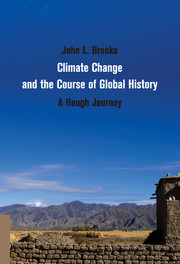Book contents
- Frontmatter
- Dedication
- Contents
- List of Figures and Tables
- Acknowledgments
- List of Abbreviations
- Introduction
- Part I Evolution and Earth Systems
- Part II Domestication, Agriculture, and the Rise of the State
- Part III Ancient and Medieval Agrarian Societies
- 6 Stasis and Growth in the Epoch of Agrarian Empires
- 7 Optimum and Crisis in Early Civilizations, 3000–500 BC
- 8 A Global Antiquity, 500 BC–AD 542
- 9 The Global Dark and Middle Ages, AD 542–1350
- Part IV Into the Modern Condition
- Data Bibliography: Full Citations for Data Used in Figures and Tables
- Index
- References
9 - The Global Dark and Middle Ages, AD 542–1350
Published online by Cambridge University Press: 05 August 2014
- Frontmatter
- Dedication
- Contents
- List of Figures and Tables
- Acknowledgments
- List of Abbreviations
- Introduction
- Part I Evolution and Earth Systems
- Part II Domestication, Agriculture, and the Rise of the State
- Part III Ancient and Medieval Agrarian Societies
- 6 Stasis and Growth in the Epoch of Agrarian Empires
- 7 Optimum and Crisis in Early Civilizations, 3000–500 BC
- 8 A Global Antiquity, 500 BC–AD 542
- 9 The Global Dark and Middle Ages, AD 542–1350
- Part IV Into the Modern Condition
- Data Bibliography: Full Citations for Data Used in Figures and Tables
- Index
- References
Summary
The millennium from AD 500 to AD 1500 is suffering from an identity crisis. The convenient labels of Dark Ages and Middle Ages have come under attack from historians seeking to unsettle our standard narrative chronology, and to get at the qualities of lived experience during these centuries. Peter Brown led the way, smoothing out the discontinuities between an Age of Rome and the Middle Ages with the construct of a “Late Antiquity” running from roughly AD 400 to AD 900, condemning the Dark Ages to outer darkness. At the other end of the spectrum, the terms late medieval and early modern, covering the period from 1350 to 1815, are equally problematic because the people of the period had no sense of themselves as ending the Middle Ages or launching “modernity,” at least before 1700. In general, historians are questioning the cultural periodization of the entire domain before 1700, proposing that it all should simply be seen as premodern. Then of course there is the question of whether modernity is a universal, or a term fundamentally a feature of North Atlantic societies from some time in the eighteenth century.
When I wear my hat as a cultural historian, I am happy to engage in these debates, but the older terms make some sense from an earth systems perspective. Here we enter directly into Victor Lieberman’s world of “strange parallels.” Just as they uncannily support traditional understandings of the chronology of a longer antiquity running between 3000 BC and the “fall of Rome,” the boundaries and constraints imposed by the action of climate and disease broadly reinforce the traditional historical chronology for the next millennium. Climate and disease made Brown’s Late Antiquity a tough time in both hemispheres, perhaps a “Dark Age.”
- Type
- Chapter
- Information
- Climate Change and the Course of Global HistoryA Rough Journey, pp. 350 - 392Publisher: Cambridge University PressPrint publication year: 2014



